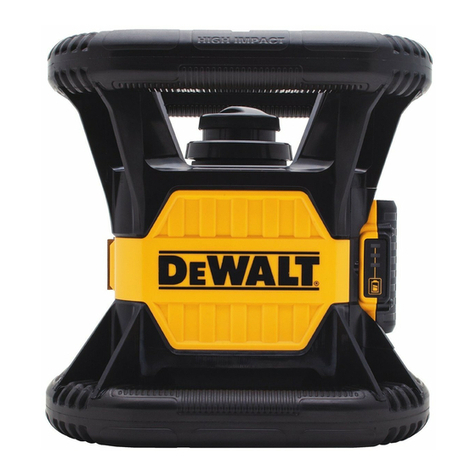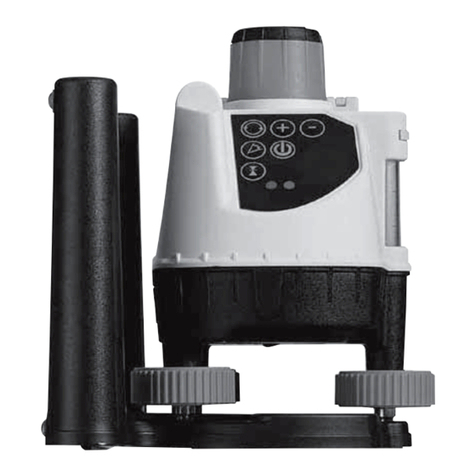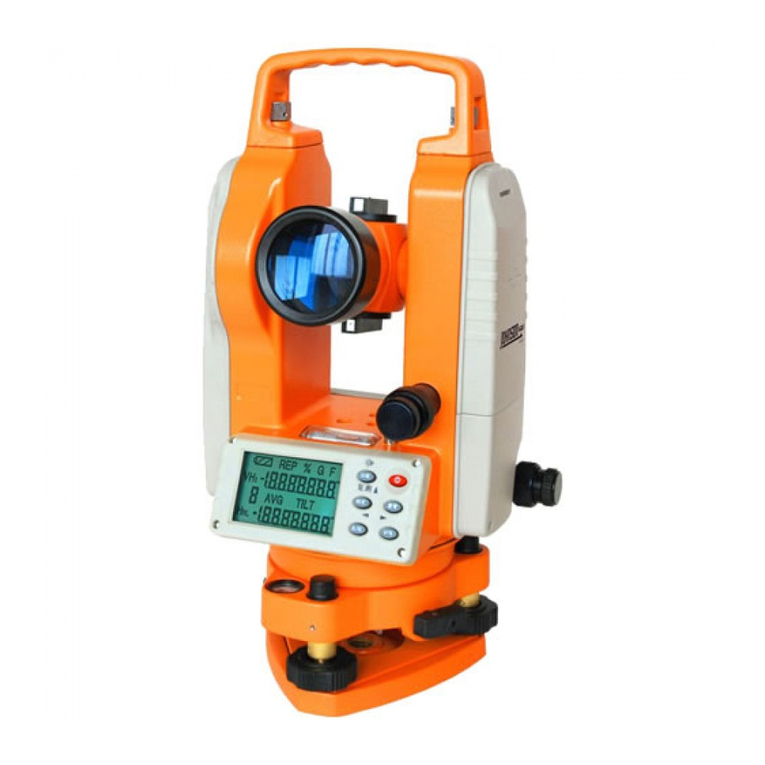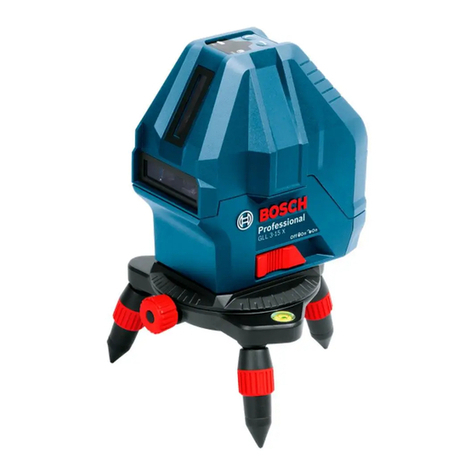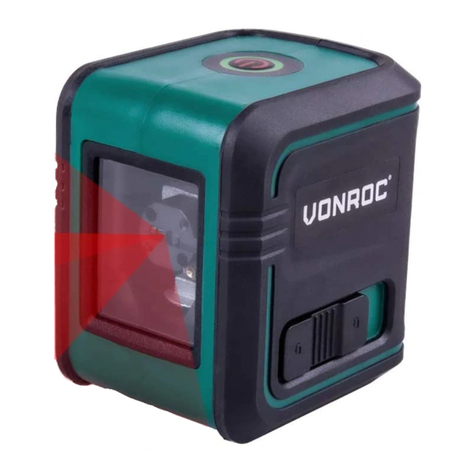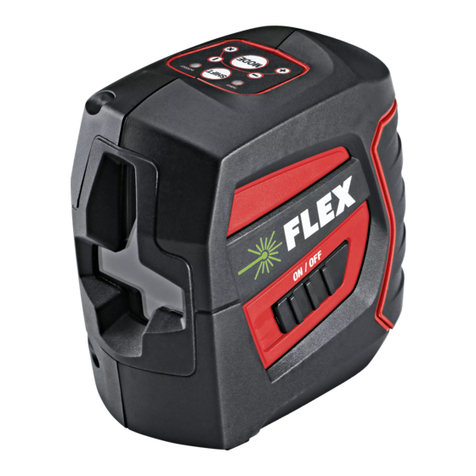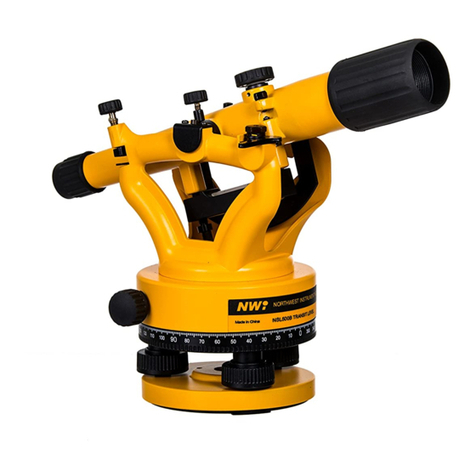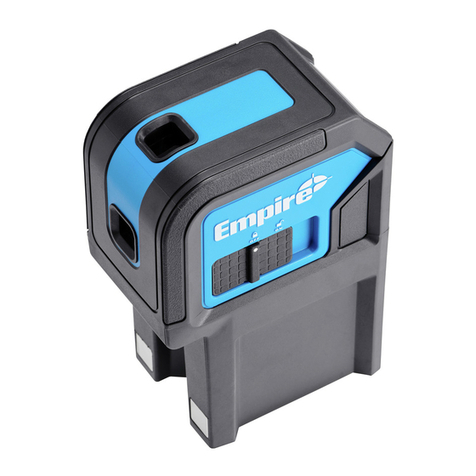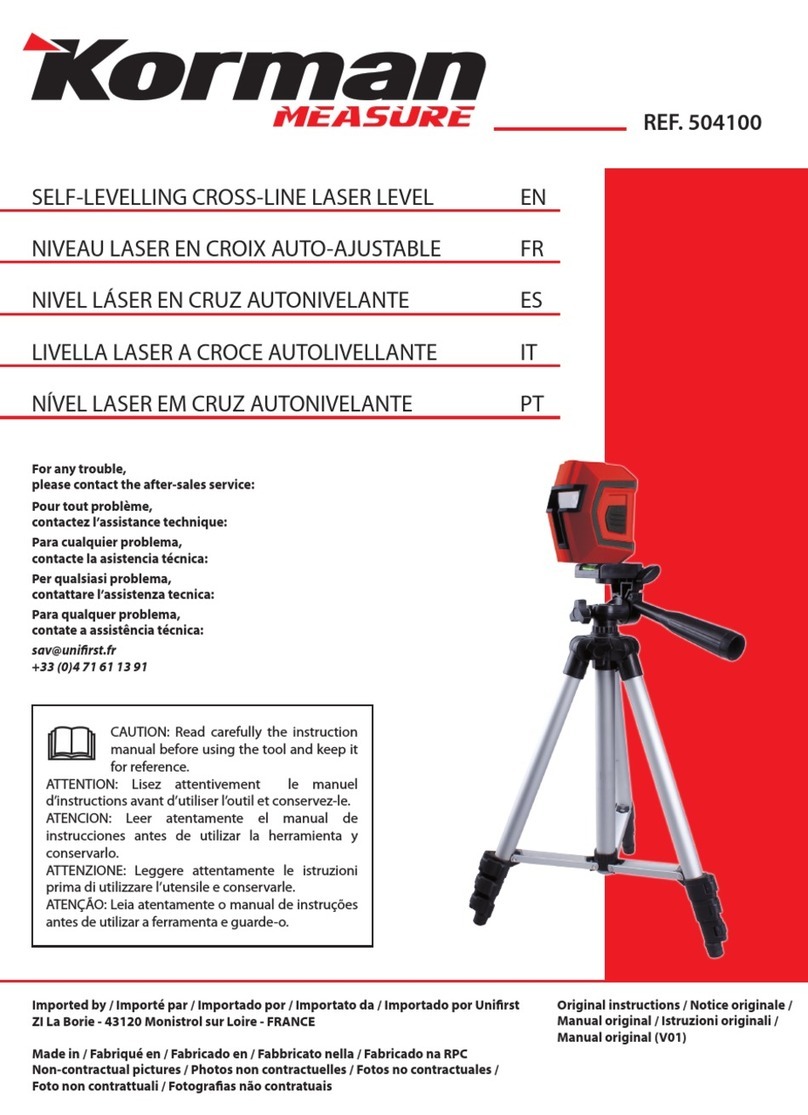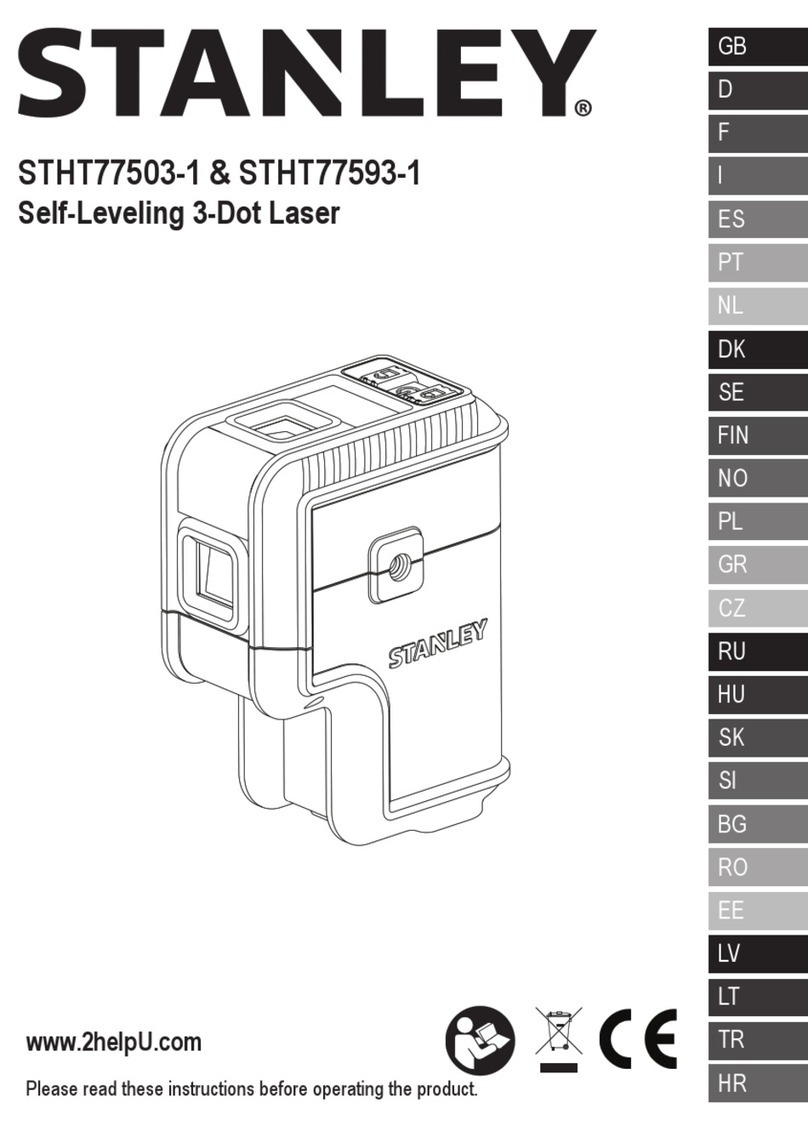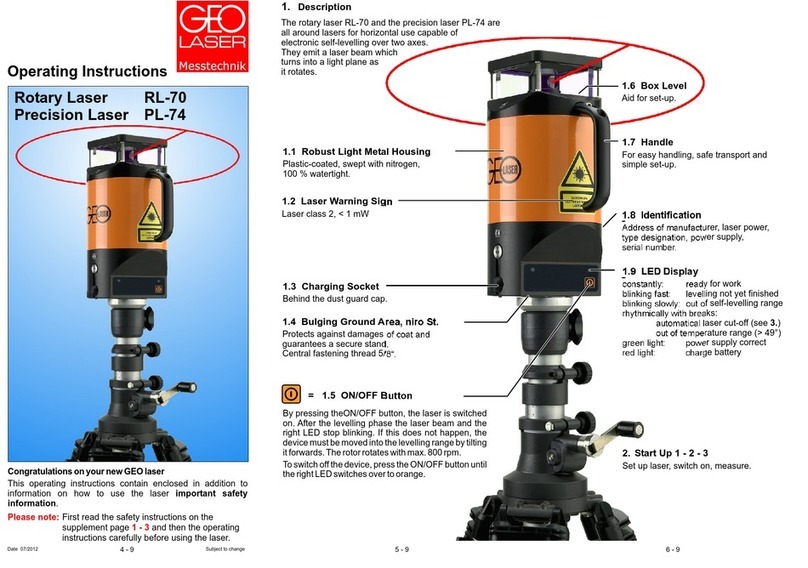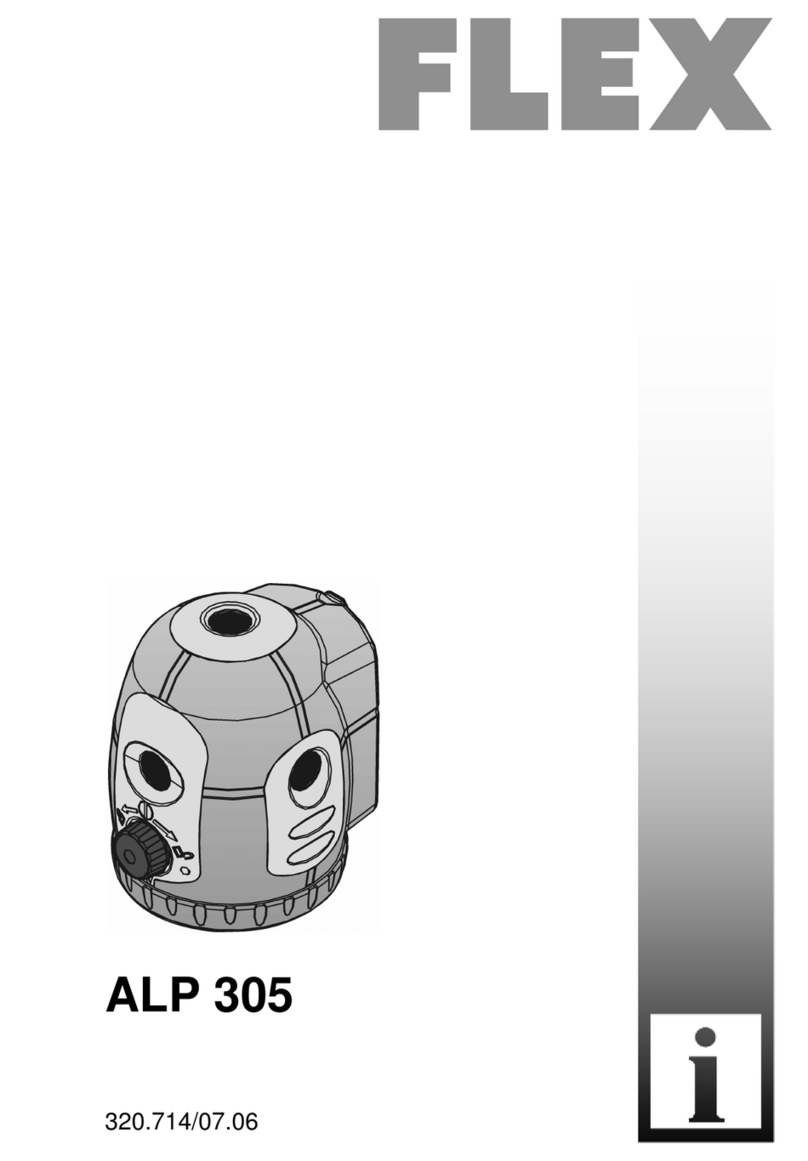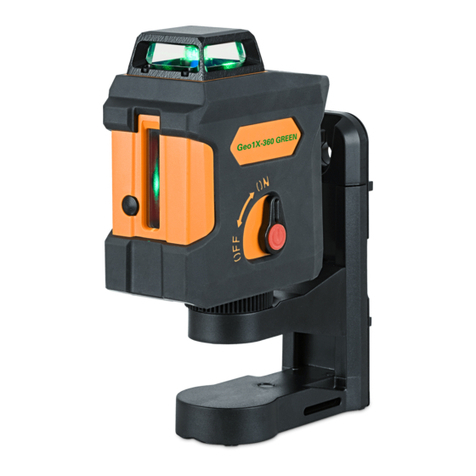Würth WLA08 User manual

Electronic Level
WLA08
WLA08-pg1-124 22/05/08 19:53 Page 1

3
GB F E D I N FIN
2
Although the WLA08 is very simple to use, we recommend that you
read this manual before operating the laser.
1.1 Description
The WLA08 is an automatic visible laser that can be used for level-
ing, vertical alignment, plumb, and squaring. Applications include
installing suspended ceilings, partitions, and a variety of outdoor
alignment work.
The WLA08 laser has these advanced features:
• Automatic self-leveling in both horizontal and vertical modes
• Motorized mount speeds setup for ceilings and partitions
• Manual leveling in X and Y axes for dual slope setting (± 10%)
• Semi-automatic single axis slope setting (automatic leveling in X
and manual leveling in Y)
• Ability to match slope for inclined planes greater than 10%
• Choice of beams, including scanning and chalk line
• Square shot that’s left and right adjustable
• Easy electronic calibration
1.2 Safety
The WLA08 is a Class 3R laser, manufactured to comply with the
international rules of safety IEC 60825-1, 2001. Although the
power of the emission of the beam is less than 5mW in Class 3R,
the following cautions are recommended:
• Do not stare directly at the beam
• Do not set up the laser at eye level
1. General information
A. CDRH warning label
1. General information 3
1.1. Description
1.2. Safety
1.3. Specifications
1.4. Laser overview
1.5. Keypad overview
2. How to use the laser 6
2.1 Setup
2.2 Automatic/Manual
2.3 HI Alert
2.4 Rotation speed
2.5 Laser chalk line
2.6 Scanning
2.7 Motorized mount
2.8 Squaring
2.9 Matching slope
3. Power 13
3.1 Installing alkaline batteries
3.2 Using rechargeable batteries
3.2 Later recharging
4. Checking and adjusting calibration 14
5. Care and handling 20
6. Warranty 20
7. Accessories 21
7.1 RCR500 detector
7.2 Remote control
7.3 Tripods
7.4 Other accessories
Table of contents
CLASS 3R LASER PRODUCT
WAVE LENGTH 630-680 nm
MAX. OUTPUT POWER: 5mW
LASER LIGHT; AVOID DIRECT EYE EXPOSURE
CONFORMS TO IEC 60825-1; 2001
WLA08-pg1-124 22/05/08 19:53 Page 2

5
GB F E D I N FIN
4
1.4 Laser overview
See inside front cover for photos of the laser and keypad corre-
sponding to these callouts. See separate descriptions of motorized
mount, remote control, and detectors.
1. Rotating head
2. Aluminum head protection with axes indications
3. Plumb or square laser beam aperture
4. Rotating laser beam aperture
5. Collar to switch between point & chalk line
6. Index marks for alignment and 90°
7. Motorized wall or floor mount
8. Batteries
9. Jack for battery charger
10. 5/8 - 11 tripod mount for horizontal set-up
11. 5/8 - 11 tripod mount for vertical set-up
12. Sensors for remote control signal
1.5 Keypad overview
13. Move left: scan or vertical alignment/
Move calibration beam up
14. Move right: scan or vertical alignment/
Move calibration beam down
15. Decrease rotation speed or scan angle/ Move stationary point
or chalk line left /
Save calibration
16. Increase rotation speed or scan angle/ Move stationary point
or chalk line right/
Change calibration axis
17. On / Off
18. H.I. Alert
19. Automatic / Manual mode
20. Low battery LED /
X axis calibration LED
21. H.I. Alert LED /
Y axis calibration LED
22. Manual mode LED /
Z axis calibration LED
Italics indicate keys and LEDs used in calibration mode.
1.3 Specifications
Recommended use 1,000 ft. (300 m) diameter
Leveling accuracy ± 3/32” at 100 ft.
(± 0.0075% ± 7,5 mm at 100 m)
Self-leveling Horizontal and vertical
Leveling range ± 10%
Rotation speed 0, 90, 150, 300, 450, 600 rpm
Scanning angle Variable, from 2 to 36°
Laser diode Visible 635 nm; <5mW Class 3R
Power 2 D size (LR20) alkaline batteries
or rechargeable batteries
Battery life 160 hours with alkaline batteries
40 hours with rechargeable batteries.
Charging time 15 hours
Remote detection 100 ft. (30 m) / 180°
Environmental Weatherproof
(rain and dust proof – IP64)
Weight 3 lbs. (1.5 kg)
Size 7.75’’x 8’’x 5.5’’ (19.5 x 21 x 14 cm)
B. Aperture label
AVOID EXPOSURE. LASER LIGHT
IS EMITTED FROM THIS APERTURE
B
A
WLA08-pg1-124 22/05/08 19:53 Page 4

7
GB F E D I N FIN
6
CAUTION:
In manual mode, the beam rotates even if
the laser is not leveled.
2.3 H.I. Alert mode
The H.I.feature stops the laser automatically and sounds an
alarm if the laser is disturbed, preventing inaccurate readings. It
functions only when selected.
To activate this safeguard feature, press the H.I. key (18) after
turning the laser on. The LED (21) will blink rapidly while the
laser is self-leveling.
About 30 seconds after the head starts to rotate, the LED will
blink slowly, indicating the H.I. Alert is activated.
If the laser is disturbed while in H.I. Alert mode, the head will
stop rotating, the beam will turn off, the LED indicator will be on
continuously, and an alarm will sound for 30 seconds.
Turn the laser off and turn it on again. Check to see if the beam
elevation has changed from its original benchmark position.
The laser is no longer in H.I. Alert mode. Press H.I. (18) to
return to H.I. Alert.
This feature is only available in automatic and semi-automatic
modes, and not in wall mount mode.
2.4 Rotation
The head rotates at 6 speeds: 0, 90, 150, 300, 450, and 600
rpm. 300 rpm is the default setting. The laser beam is more visible
at slower rotation speeds.
To increase rotation speed, press the + key (16) on the laser. Press
the – key (15) to decrease speed. Hold the – key to stop rotation.
When the beam is stopped, the point can be moved to the right or
left using the > or < keys (13 and 14). You can also move the head
manually to position the beam point. To start rotation again press +
key (16).
2.1 Setup
The motorized wall mount and the metal head protection can both be
removed from the laser, if you wish to work without these attachments.
• Horizontal
The laser can be mounted on a 5/8-11 tripod (10) or placed
directly on a solid, stable surface. It can also be suspended from a
ceiling grid using the wall mount (see later section).
• Vertical
The laser can be mounted on a 5/8-11 tripod (11) or placed
directly on its back (opposite the handle) on a solid, stable surface.
For more stability, we recommend you to use the motorized mount.
Use the support plate for stability when in vertical mode.
The WLA08 has a wide self-leveling range; however, if the laser is
set up out of the leveling range, laser beam will continue to blink
and rotation will not start.
• Turning on the laser
Turn on the laser with the On /Off key (17). It does a self-test
and the beam blinks while the laser is self-leveling. After it’s
leveled, the head rotates. You can choose H.I. Alert mode or
change to manual mode (see below).
2.2 Automatic / Manual modes
The WLA08 is in automatic self-leveling mode when turned on.
Once the instrument has self-leveled, the laser head will start rotating.
In manual mode (19), the laser does not self-level: this means
that the beam will rotate even if the laser is not leveled. It can
therefore be used on inclined planes such as stairs, roofs, or
when manual grade setting is required. See later section on set-
ting slope in manual or semi-automatic modes.
2. How to use your WLA08 laser
WLA08-pg1-124 22/05/08 19:53 Page 6

9
GB F E D I N FIN
8
6. Moves laser manually on mount
7. Holes for attaching mount to wall
8. Adjustable support for wall or ground stability
9. Screw to adjust support
10. Index notches for alignment
2.7.1 Motorized mount
The motorized mount can be used to move the laser up or down on
a ceiling grid. It also can be used when installing walls and partitions,
to move the laser back and forth for vertical alignment. To move the
mount manually, use (6).
Caution:
Be careful when you are in wall mount mode not to press + or
-
keys unless you intend to move the laser.
Maximum movement
When the beam is at 0 on the adjustable plate, the laser can be
raised a maximum of 2” (50 mm) and lowered 2.25” (60 mm).
Wait until self-leveled
While the laser is moving on the mount, it does not self-level and
the beam continues to rotate. After moving the laser, wait a few
seconds in case it needs to self-level. Check that it’s still on the point
or level desired, and make adjustments if needed.
Automatic exit from mode
If you have not activated the wall mount for five minutes, the laser
will automatically exit from wall mount mode and return to the pre-
vious mode (3 LEDs will be off and a beep will sound).
1. Attachment clamps for laser and mount
2. Clamp for ceiling grid
3. Adjustable plate
4. 5/8-11 tripod mount (vertical setup)
5. Release for adjustable plate
1
1
10
2
6
9
8
4
3
7
7
5
2.5 Using the laser chalk line
Ideal for short distance applications, the chalk line feature gives a
precise and stable laser line for working directly on your reference
plane.
To use the laser line, stop the rotation and flip up the collar located
on the side of the rotating head. This collar switches between point
and line modes.
You can move the stationary chalk line left by pressing key (13)
and right, by pressing key (14). You can also move the head manu-
ally or use the remote control.
If the laser is in chalk line mode, the detector will not
work. Switch to rotating point mode to detect the beam.
2.6 Scanning
For interior applications, scanning mode allows you to see the
beam easier at a distance.
If the laser is in chalk line, switch to beam point mode before scanning.
1. To scan, simultaneously press the – and < keys (15 and 13) on
the laser or press the scanning symbol on the remote control or the
detector.
2. The beam will blink until the laser has self-leveled.
3. To decrease the scan length, press the – key (15); to increase
the scan length, press the + key (16). Keys on the remote control or
detector can also be used for the scan functions.
4. To move the scan to the left, hold the < key. To move to the right,
use the > key (13 and 14).
5. To stop scanning, again press simultaneously on the – and < keys
(15 and 13).
2.7 Motorized mount
2.7.1 Motorized mount
The motorized mount can be used to move the laser up or down on
a ceiling grid. It also can be used when installing walls and partitions,
to move the laser back and forth for vertical alignment. To move the
mount manually, use (6).
WLA08-pg1-124 22/05/08 19:53 Page 8

11
GB F E D I N FIN
10
knobs (1) should be turned fairly tight to make contact for the
motor, although do not overtighten.
2. Flip down the support plate (8) and place the laser in vertical
mode on the floor.
3. If the support plate is not level, use the screw (9) to adjust.
4. Press the scanning keys (15 and 13) and hold them for a few
seconds until you hear 4 beeps. This will put the laser in “wall
mount mode”. All three LEDs will blink.
5. Press the + or - keys to move the laser back and forth. Holding
the key will result in fast movement; short clicks will move the laser
more precisely.
If you don't move the mount for 5 minutes, the laser will go back to
its previous mode. You'll hear a 4-second beep.
2.8 Squaring
After placing the laser in vertical position, the plumb beam out the
top of the head can be moved to the left or right. This is necessary
to do squaring for installing walls and partitions.
To position the rotating plane perpendicular to a reference line:
1. Place the laser on the ground so that the index notch on top of
the adjustable plate is over your reference point.
2. After the laser has self-leveled, stop the head rotation. Turn the
head down so that the beam is on the adjustable plate.
3. Hold the scan key several seconds to put in wall mount mode.
Use the < or > keys (13 and 14) to adjust the laser so that the
beam is on the reference point.
4. Exit from wall mount mode using the scan key. Align the beam
projecting from the top of the head to your second reference point
using the < or > keys (13 or 14). This beam is 90° or square to the
other vertical plane beam.
5. Start rotation of the head.
It is very important to check while you are using the
laser that it has not been moved and that your setting
is still accurate.
Functions not available
H.I. Alert, setting slope in manual mode, or moving the scan or
plumb point are not available in wall mount mode. Exit wall mount
mode to use these functions.
Detaching the mount
Screw both knobs (1) all the way out to detach the mount from the laser.
Troubleshooting
If the laser does not move on the mount, check that the knobs (1)
are tight enough to make the power contact for the motor. The
mount can also be detached to check that the contacts where the
laser and mount are fastened are clean.
2.7.2 Using the laser with wall mount
on a ceiling grid
Setup:
1. Check that the laser and mount are connected securely. The
knobs (1) should be turned fairly tight to make contact for the
motor, although do not overtighten. Check that the safety clip
is well engaged.
2. Flip down the support plate (8).
3. Release the clamp (2) on top of the adjustable plate (3).
4. Lock the clamp against the ceiling grid. The grid should not
exceed 1/8" 3mm thickness.
5. If the foot on the support plate is not touching the wall, use the
screw (9) to adjust.
To move the laser up or down with the remote control:
1. Turn on the laser and wait for it to self-level. The head must be
rotating before you can enter wall mount mode.
2. Press the scanning key and hold it for several seconds until you
hear 4 beeps. This will put the laser in “wall mount mode”. All
three LEDs will blink.
3. Press the + key to move the laser up; press - to move the laser
down. Holding the key will result in fast movement; short clicks will
move the laser more precisely.
If you don't raise or lower the wall mount for 5 minutes, the laser
will go back to its previous mode. You'll hear a 4-second beep.
2.7.3 Using the motorized mount
and laser on the floor
1. Check that the laser and mount are connected securely. The
WLA08-pg1-124 22/05/08 19:53 Page 10

13
GB F E D I N FIN
12
2.9.3 Inclined plane
The laser can also be tilted, for manual slope, at various angles on the
wall mount. A tripod with rotating mounting plate will speed setup.
1. Set the laser in vertical mode, preferably on a tripod. If set-
ting on the ground, flip down the support plate for stability.
2. After the laser has self-leveled, set in manual or semi-auto-
matic mode.
3. Loosen the knobs on either side (1) to partially separate the
mount from the laser.
4. Move the laser to the approximate inclined position and
tighten slightly.
5. Move to the final position and tighten further.
When battery power is low, the laser head will stop rotating and
the low battery LED next to the On/Off key will stay on (20).
3.1 Installing alkaline batteries
1. To access the battery compartment, loosen the knobs connecting
the laser to the wall mount.
2. Use a coin or a screwdriver to remove the cover of the battery
compartment at the back of the laser.
3. Insert two alkaline batteries (D size or LR20), following the polar-
ities indicated at the bottom of the battery compartment. (The + con-
tact is rounded and raised). When replacing the batteries, change
both at the same time.
4. Replace the compartment and tighten with a coin or screwdriver.
3.2 Using rechargeable batteries
If your laser has a rechargeable battery, you must charge it for 15
hours before first using the laser.
1. Insert the charger plug into the jack located at the back of the
laser, under the wall mount.
2. Plug the charger into an electrical outlet (110 volts or 220 volts).
3. Charge for 15 hours.
3. Power
2.9 Manual slope
The WLA08 can be used to set a manual slope on both X and Y axes.
Two modes are available
• Complete manual mode: X and Y axis will be both manual
• Semi-automatic mode: X in automatic / Y in manual
For slopes up to 10%, set up the laser in horizontal mode and use
the remote to set the slope following instructions below.
For slopes greater than 10%, set up the laser in vertical mode and
use the inclined plane feature (next section).
2.9.1 Manual mode
1. After turning the laser on and allowing it to self-level, press the
Man key (19). The LED next to it (22) will blink, indicating you are
in manual mode and you can set slope in the X axis. The head will
start rotating.
2. Turn the laser so that X on the top of the head protection faces
the direction of the slope (and X’ faces away).
3. Press < (13) to set a positive slope in X and > (14) to set a neg-
ative slope.
4. To switch to the Y axis, press the H.I. key. Both LEDs (21 and 22)
will blink, indicating you’re in manual mode and can set slope in
the Y axis.
5. Turn the laser so that Y on the top of the head protection faces
the direction of the slope (and Y’ faces away).
6. Press < (13) to set a positive slope in Y and > (14) to set a nega-
tive slope.
2.9.2 Semi-automatic mode
1. After turning the laser on, hold the Man key (19) for a few sec-
onds. The LED next to it (22) will be on continually. The laser is in
automatic self-leveling mode in X axis, and manual mode in Y axis.
2. You can to use the H.I. Alert (18) safeguard function on the X
axis while Y is on manual.
3. Press < (13) to set a positive slope in Y and > (14) to set a
negative slope. The X axis will stay level.
Press twice on the Man key to return to the automatic mode.
IMPORTANT: In manual mode, the head will rotate
even if the laser is not leveled. The H.I. Alert function
is not available when your laser is in manual mode.
WLA08-pg1-124 22/05/08 19:53 Page 12

15
GB F E D I N FIN
14
Each end of each axis must be checked for calibration. If needed,
the axis can be calibrated, carefully following the instructions. You
can also take the laser to a service center for calibration.
Check and calibrate in this order:
Check both sides of X axis.
• If X is within spec, proceed to check both sides of Y.
• If X needs calibration, calibrate X
Check both sides of Y axis.
• If Y is within spec, proceed to final X to Y check
• If Y needs calibration, calibrate Y; proceed to X to Y check
Final X to Y check: compare X, X’, Y, Y’
Check Z and calibrate if necessary.
4.1 Calibration overview
Calibration is electronic, using the remote control or detector. The
keypad of the laser may also be used, but it will take longer due to
the laser making self-adjustments during movement.
If the beam is visible, calibrate using the non-rotating point. If it’s
too bright to see the beam, you’ll use the detector and will need to
have the beam rotating. When you’re in calibration mode, press
the scan key on the detector to rotate the beam.
The axis LED should blink slowly when in calibration mode. When
the laser is self-leveling or making an adjustment, the LED will blink
rapidly.
IMPORTANT:
When pressing an arrow key to move the beam for
calibration, use short, rapid clicks. Do not hold the key
down. One click will move the beam a very small
amount (1/32" at 150' or 1mm at 100 meters). After
pressing the key, the LED will blink rapidly as the laser
reacts. Wait until the LED returns to a slow blink to
proceed.
3.3 Later recharging
The laser can be charged when working, if electricity is available
on the jobsite. Simply plug in the charger and keep on working.
You can also remove the battery pack to charge it, and replace it
with the alkaline battery compartment to keep on working.
For optimum life of the battery, it is recommended to charge the
battery after fully discharged. To assure battery life, do not charge
over 20 hours.
The battery and the charger can be damaged if damp. Always
store and charge your laser in a dry and covered place.
THIS CHAPTER IS VERY IMPORTANT. Here are a few simple instruc-
tions to check your WLA08 for calibration. Remember that the laser
is a precision instrument and that it is important that you keep it
calibrated and in proper condition.
The accuracy of your job is completely your responsibility and
you should regularly check your instrument especially prior to
important jobs.
The laser has 3 axes: X and Y (horizontal) and Z (vertical), as indi-
cated on the top of the laser.
4. Checking and adjusting your WLA08
Y
X
X’
Y’
WLA08-pg1-124 22/05/08 19:53 Page 14

17
GB F E D I N FIN
16
7. After completing the X calibration, press the + or >>Ikey (16)
to change the axis and to calibrate the Y axis. When the Y LED
blinks slowly, the laser is ready to be calibrated on the Y axis.
8. If the Y axis does not have to be calibrated, press the -or .key
(15) to save the calibration you have just made on X axis. The laser
will shut off. If you are not sure of the calibration and do not wish
to save it, turn the laser off with the On/Off key.
4.4 Checking Y axis
1. Rotate the laser 90 degrees so that Y is facing the wall.
2. Mark the location of the center of the beam.
3. Rotate the laser 180 degrees so that Y faces the wall.
4. Mark the location of the beam center near the first mark.
5. At 100 ft., the marks should be no more than 3/16” apart (at
30m, no more than 5mm apart). This is within the stated accuracy
of ± 3/32” at 100 ft. (± 0.0075%).
6. If the marks are close enough, Y axis is within calibration.
Proceed to “Final X to Y Check.” If the marks are not close enough,
Y axis needs to be calibrated.
4.5 Calibrating Y axis
The laser must be calibrated to bring the beam to the center of the
two Y marks. Read "Calibration Overview" before proceeding.
If you are still in calibration mode from the X axis, press the + or >>I
key (16) to change to the Y axis. When the Y LED (21) blinks
slowly, it’s ready to be calibrated in Y axis.
If you’re no longer in calibration mode:
1. Turn off the laser.
2. While keeping “Man” (19) pressed, turn on the laser (17).
3. After the 3 LEDs blink in sequence, release Man key.
4. The X LED (20) will blink. The beam will not be
rotating. If the Z LED is blinking and the beam is rotating, it is not in
calibration mode. Turn off and repeat the steps above.
5. Press the + or >>Ikey (16) to change to Y axis. Y LED (21) will
blink rapidly for a bit and then slowly, indicating it’s ready to be
calibrated in Y axis.
If you have not moved the laser, use the Y marks made in previous
steps of “Checking Y axis”.
4.2 Checking X axis
1. Place the laser on a flat surface or tripod 100 ft. (30 m) away from
a wall. Position so that X (noted on top of laser) is facing the wall.
2. Turn on the laser.
3. Mark the location of the center of the beam. If it’s too bright to
see the beam, use a detector, or put in scan mode.
4. Rotate the laser 180 degrees so that X faces the wall.
5. Mark the location of the center of the beam near the first mark
so that both marks are in line, one above the other.
6. At 100 ft., the marks should be no more than 3/16” apart (at
30m, no more than 5mm apart). This is within the stated accuracy
of ± 3/32” at 100 ft. (± 0.0075%).
7. If the marks are close enough, X axis is within calibration. The
second axis (Y) must then be checked (see later section).
If the marks are not close enough, the X axis needs to be calibrated.
4.3 Calibrating X axis
The laser must be calibrated to bring the beam to the center of the
two X marks.Read "Calibration Overview" before proceeding.
1. Turn off the laser.
2. While keeping “Man” (19) pressed, turn on the laser (17).
3. After the 3 LEDs blink in sequence, release Man key.
4. The X LED (20) will blink rapidly for a bit and then slowly,
indicating it’s ready to be calibrated in X axis. The beam will not
be rotating.
If the LED (22) is blinking and the beam is rotating, it is not in cali-
bration mode. Turn off and repeat the steps above.
5. If you have not moved the laser, use the X marks made in
previous steps of “Checking X axis”. If you need a rotating beam
for the detector, press the scan key.
6. Use the arrow keys to move the beam up or down to the
halfway mark. If the X axis is toward the wall with the marks, use
the < key (13) to raise the beam, and the >key (14) to lower the
beam. (If X’ faces the wall, the movement is the opposite).
WLA08-pg1-124 22/05/08 19:53 Page 16

19
GB F E D I N FIN
18
1. Turn off the laser (17).
2. While keeping “Man” (19) pressed, turn on the laser (17).
3. After the 3 LEDs blink in sequence, release Man key.
4. The X LED (20) will blink.
5. Press the “MAN” key (19) to change to Z axis. The Z LED (22)
will blink rapidly for a bit and then slowly, indicating it’s ready to
be calibrated in Z axis. The beam will not be rotating.
When it’s in calibration mode, rotate the beam by pressing the
scan key, and make these adjustments:
1. Use the < and > keys (13 and 14) until the beam is perfectly
vertical and parallel to the plumb line.
2. Move the beam slightly so that the beam is over the plumb line
for the final check.
3. After completing the Z calibration, press the -or . key (15) to
save it. The laser will shut off. If you are not sure of the calibration
and do not wish to save it, turn the laser off with the On/Off key.
4.9 Cone error checking
1. Set up the laser about 2 feet (60 cm) away from a wall (A)
or a pole and 100 feet (30 m) from another wall or pole (B).
2. Turn the laser on.
3. After it has self-leveled, stop the rotation and mark the loca-
tion of the beam (center of the beam) on the near wall (A). Use
a detector if ambient conditions are too bright.
4. Rotate the laser 180°. Mark the location of the center of the
beam on the far wall (B).
5. Set up the laser about 2 feet (60 cm) away from the far
wall. After the laser has self leveled, line up the beam near the
previous mark (B), and make a new mark (B').
6. Mark the location of the beam (A’) on the other wall near the
first mark (A) using the detector if necessary.
7. Compare the two sets of marks on the wall. If the difference
between AA’-BB’ exceeds 3/16" (5 mm), contact your local
service center.
6. Use the arrow keys to move the beam up or down to the
halfway mark. If the Y axis is toward the wall with the marks, use
the < key (13) to raise the beam, and the > key (14) to lower the
beam.
7. After completing the Y calibration, press the -or . key (15) to
save the calibration you have just made on Y axis. The laser will
shut off. If you are not sure of the calibration and do not wish to
save it, turn the laser off with the On/Off key.
4.6 Final X to Y Check
As a final check of the horizontal axes, compare X and Y axes
to be sure that your adjusted calibration is within the specs of ±
3/32”. The marks for X, X’, Y, and Y’ should be no more than
3/16” apart at 100 ft. (5mm at 30m). If X and Y are within
spec, proceed to checking Z axis.
4.7 Checking Z axis
1. Place the laser in vertical mode on a solid, stable surface about
20 ft. away from a plumb line (plumb bob or heavy object hanging
on a string, at least 8 ft. high). You will be comparing the rotating
beam to the plumb line. If you need to calibrate, the beam will be
easier to see in a darkened room.
2. Use the support plate (8) for stability.
3. Turn on the laser.
4. Use either scan or rotation mode. Using the scanning beam is
easier, but if you cannot see the beam, work in rotation mode with
a detector.
5. Move the scan to the wall over the plumb line, sliding the laser
left or right to line up the beam over the plumb line. If in rotation
mode, use the < or > keys (13 or 14) to move the beam.
6. Move the scan up and down the entire length of the plumb line.
If the beam is slanted, and not vertical like the plumb line, the Z
axis needs to be calibrated.
4.8 Calibrating Z axis
The laser must be calibrated to bring the rotating Z beam parallel
to the plumb line.
WLA08-pg1-124 22/05/08 19:53 Page 18

21
GB F E D I N FIN
20
7.1
Combination detector and
laser remote control
For grade rod or handheld applications. Also can use the magnet
mount to attach to metal studs for exterior curtain wall alignment or
to ceiling grids for acoustical ceiling leveling.
LCD
screen (front)
On-grade
alignment notch
Detection
window
Magnet Window for remote’s
infrared signal
Level vial
7. Accessories
LCD screen
(rear)
Bubble
vial to
plumb rod
9V battery
compartment
(follow polarity
indications inside)
Use a coin to unscrew
the battery cap
Turn to attach
clamp to
detector
Turn to tighten
or remove clamp
from rod
CAUTION
Using of controls or adjustments of procedures other than those
specified herein may result in hazardous radiation exposure.
The WLA08 is a precision instrument which must be handled with
care. Avoid shock and vibrations. Always store and transport the
laser and its accessories in the carrying case.
Although weather resistant, you must always keep your laser and its
accessories dry and clean after using. This will increase the battery life.
Do not store your laser at temperatures below -4°F (-20°C) or
above 176°F (80°C) because some electronic components could
be damaged.
Do not store your instrument in its case if the instrument or the case
are wet, to avoid water condensation inside the instrument.
To maintain the precision of your WLA08 check and adjust it regularly.
Keep the lenses of the apertures dry and clean. Use a soft cloth
and glass cleaner to clean them.
We recommend to regularly charge the batteries of the WLA08.
Nevertheless, make sure to charge them only when they are out of
power or becoming so. Recharging batteries that are still useable
will shorten their capacity.
The WLA08 laser is guaranteed to be free of manufacturing defects
for a period of one year. Any abnormal usage or if the instrument
has been subjected to shock will void this warranty. Under no cir-
cumstances will the liability of the manufacturer exceed the cost of
repairing or replacing the instrument.
Disassembling the instrument by other than qualified and certified
technicians will void this warranty.
Specifications subject to change without notice.
5. Care and Handling
6. Warranty
WLA08-pg1-124 22/05/08 19:53 Page 20

23
GB F E D I N FIN
22
Low battery
Blinking: Normal volume
Solid: Loud
No horn: Mute
Standard
(Default mode)
Fine
Low
Near
grade low
On-grade
Near
grade high
High
BATTERY STATUS
SOUND
ACCURACY
• LCD Display
• Detection mode
1. Press the On/Off key to turn on the detector.
2. Press the middle key to select the accuracy (deadband).
3. Press the top key to select the sound level.
4. Turn the detection window towards the laser beam, and move
the detector up or down according to the information given on
the LCD display. There are 5 channels of information, or grade
indicators.
A down arrow indicates you must move the detector down to
reach the laser reference; an up arrow, move it up. When a hor-
izontal line appears on the display, the detector is at the same
level as the laser beam.
5. Press the On/Off key to turn the detector off. It will automati-
cally shut off after 10 minutes if not used (and give a warning
beep).
6. Keep the detection window clean, using a soft cloth and glass
cleaner.
•
Remote control mode
The detection mode has to be stopped to use the remote control
mode.
Choice of
sound level Move square
shot to the left
Move square
shot to the right
Increase
scanning angle
Decrease
scanning angle
and are used for calibration
or to set manual grade
Choice of
accuracy
On/Off
• Upper Keypad
Detector mode
(red keys)
Remote mode Scanning mode
• Lower Keypad
Increase
rotation speed
Decrease
rotation speed
Start/Stop scanning mode
Calibration section of manual explains
function of secondary small symbols.
Aim scanning left
Aim scanning right
Remote mode Scanning mode
TROUBLESHOOTING
• Before using a detector, it is very important to set the A510S
in point mode. The receiver cannot detect the beam in
chalk line mode.
• If you cannot pick up the beam with the detector, check how
you are lined up with the laser. One of the head protection sup-
ports on the laser may be blocking the beam; move to the left
or right to receive the beam.
• The metal head protection can be removed from the laser by
pivoting the two security locks. This will not affect the perform-
ance or the water or dust resistance of the laser.
WLA08-pg1-124 22/05/08 19:53 Page 22

2524
GB F E D I N FIN
You cannot move the scan, plumb point, or slope in wall mount
mode. Exit this mode to use keys 4 & 5 for these functions.
The remote control can also be used for calibrating.
To open the battery compartment and change the battery, push
the battery cover in the direction of the arrow.
7.3 Tripods
The laser can be mounted on a 5/8-11 flat head tripod. You
can also use a tripod with an elevating column to adjust the
height of the laser.
7.4 Other accessories
1. Laser-enhancing glasses improve the visibility of the laser
beam in bright light conditions.
2. Red magnetic target improves the visibility of the laser beam
in bright conditions. Quickly attaches to any metallic surface.
Warranty
The manufacturer warrants its measuring instruments against all
manufacturing defects for a period of one year from date of
purchase. If during the warranty period, the product is consid-
ered as defective by the manufacturer, the latter will decide
whether to repair or exchange the product. The only obligation
and sole recourse of the buyer will be limited to this repair or
exchange.
The manufacturer, the distributor or the retailer will in no case
be responsible for any incident or consequence, damage, etc.
relative to the use of those instruments.
Limits and exclusions: the warranty will not apply to any dam-
age resulting from negligence, accident, misuse, repair or stor-
age or in case of abnormal use.
The remote can be used to stop or start rotation, increase or
decrease rotation speed, and move the beam or square shot. It also
controls scanning and electronic calibration.
• Specifications
Range* 500 ft. (150 m) in detection mode
100 ft. (30 m) in remote mode
Accuracy* Fine ± <1/16" (1 mm)
Standard ± 1/8” (2.5 mm)
Battery life 50 hours; 9V alkaline
Environmental Waterproof (IP66+)
Size 6” x 3.25” x 1.5”; 10 oz**
(15 x 8 x 3.5 cm / 280 g**)
* Varies with laser used. Actual accuracy depends on beam diameter and
distance to the laser.
**With batteries
7.2 Remote control
Remote window
Battery location
4
5
3
2
1
Beam or
chalk line mode
1.
2. Decrease rotation
speed
3. Increase rotation
speed
4. Move stationary point
or square shot left
5. Move stationary point
or square shot lright
Scanning
1. Scan On / Off
2. Decrease scan length
3. Increase scan length
4. Move scan left
5. Move scan right
Motorized Mount
1. Press 3 seconds to
activate wall mount
2. Move laser up
3. Move laser down
WLA08-pg1-124 22/05/08 19:53 Page 24

Laser Automatique
WLA08
WLA08-pg1-124 22/05/08 19:53 Page 26

2928
GB F E D I N FIN
Bien que le WLA08 soit simple d’utilisation, nous vous recomman-
dons vivement de lire ce manuel avant de l’utiliser.
1.1 Description
Le niveau laser WLA08 est un laser automatique visible qui peut
être utilisé pour réaliser des nivellements, des alignements verticaux,
des équerrages,…Les applications possibles de ce laser sont la
pose de faux-plafonds, les planchers techniques, les cloisons et une
grande variété d’applications extérieures.
Le WLA08 possède les fonctions suivantes :
• Calage automatique en mode vertical et horizontal.
• Choix de rayons : point / ligne / scanning
• Calibrage électronique
• Equerrage permanent / Alignements vertical droite / gauche
• Support mural motorisé de série / Support pour plan incliné
1.2 Sécurité
Le WLA08 est un laser de Classe 3R et répond aux normes interna-
tionales de sécurité sur les lasers EN60825-1. Bien que la puis-
sance du rayon n’excède pas 5mW dans la classe 3R, nous vous
demandons de respecter les points suivants :
• Ne pas fixer directement le rayon laser
• Ne pas faire passer le rayon à travers un instrument optique.
1. Généralités
CLASS 3R LASER PRODUCT
WAVE LENGTH 630-680 nm
MAX. OUTPUT POWER: 5mW
LASER LIGHT; AVOID DIRECT EYE EXPOSURE
CONFORMS TO IEC 60825-1; 2001
1. Généralités 29
1.1 Description
1.2 Sécurité
1.3 Spécifications
1.4 Vue
1.5 Vue du clavier
2. Utilisation du WLA08 31
2.1 Mise en station
2.2 Fonction Man
2.3 Fonction H.I.
2.4 Vitesse de rotation
2.5 Ligne Laser
2.6 Scanning
2.7 Support motorisé
2.8 Equerrage
2.9 Pente manuelle
3. Alimentation 38
3.1 Installer les batteries
3.2 Remplacer les piles alcalines
3.3 Utiliser les batteries rechargeables
3.4 Recharger les batteries
4. Vérifier et calibrer le WLA08 39
4.1 Contrôle et calibrage horizontal
4.2 Contrôle et calibrage vertical
4.3 Contrôle d’erreur conique
5. Entretien et Recommendations 43
6. Garantie 43
7. Accessoires 44
7.1 Cellule de Réception
7.2 Télécommande
7.3 Trépieds
7.4 Autres accessoires
Sommaire
WLA08-pg1-124 22/05/08 19:53 Page 28

31
GB F E D I N FIN
30
Sauver les données de calibrage
16. Augmenter la vitesse de rotation - Augmenter angle de scanning/
Changer l’axe de calibrage
17. Marche / Arrêt
18. Activation de la fonction H.I.
19. Activation du mode manuel
20. Signal de batterie faible /
Signal de calibrage de l’axe X
/
Témoin de réception de la télécommande.
21. Signal de H.I. en fonction /
Signal de calibrage de l’axe Y
22. Signal d’activation du mode manuel /
Signal de calibrage de
l’axe Z
Les fonctions en italique correspondent aux fonctions du mode calibrage.
2.1 Mise en station
• Horizontale :
1. Le WLA08 peut être posé directement sur le sol ou peut être fixé
sur un trépied standard en utilisant son insert 5/8 ‘’.
2. Appuyer sur la touche Marche/Arrêt (17). L’appareil se
mettra de niveau automatiquement.
3. Pour sélectionner le mode manuel, appuyer sur Man (19).
4. Pour activer le mode H.I., appuyer sur la touche H.I. du clavier
(18). Cette fonction ne sera activée que 30 secondes après le
démarrage de la rotation de la tête.
5. Si vous souhaitez stopper la rotation et positionner manuellement
le point laser où vous souhaitez, appuyer sur la touche (-) (15)
jusqu’à l’arrêt de la tête.
6.
Pour augmenter ou diminuer la vitesse de rotation de la tête,
appuyer sur la touche (-) ou (+) du clavier (15 ou 16), 6 vitesses de
rotation
différentes sont disponibles. Vous pouvez choisir la vitesse la plus
adaptée à votre application selon les conditions ambiantes de
luminosité.
7. Pour éteindre le WLA08, appuyer sur la touche Marche/Arrêt (17).
2. Comment utiliser le WLA08
1.3 Specifications
Distance d’utilisation 300 m de diamètre
Précision
± 0.0075% ± 7,5 mm à 100 m
Nivellement automatique Horizontal et verrtical
Plage de nivellement +/- 10% ; 5,7°
Vitesse de rotation 0-90-150-300-450-600 rpm
Angles de scanning De 2 à 36°
Diode laser 635 nm, < 5mW Class 3R
Energie 2 Piles alcaline type D ou batterie rechargeable
Temps de charge 15 heures
Autonomie 40 heures avec batteries rechargeables
jusqu’à 160 heures avec piles alcalines
Angle de détection de la télécommande 180°
Poids 1,5 Kg / 3 lbs
Dimensions 21 x 17,5 x 13,5 cm
Etancheité Résistant à la pluie et à la poussière (IP 64)
1.4 Vue du laser
1. Tête rotative.
2. Protection de tête en aluminium résistant
3. Sortie du rayon laser pour équerrage ou alignement vertical
4. Sortie du rayon laser horizontal
5. Clapet Mode ligne /Mode point
6. Index pour alignement et 90°
7. Pieds ajustables pour plans verticaux
8. Emplacement de la batterie
9. Connecteur Jack pour recharge de l’appareil
10. Insert horizontal pour trépied standard (5-8’’)
11. Insert vertical pour trépied standard (5-8’’)
12. Capteurs pour télécommande
1.5 Vue du clavier
13. Alignement vertical gauche - Déplacement scanning gauche /
Monter le point
14. Alignement vertical droit - Déplacement scanning droit /
Descendre le point
15. Réduire la vitesse de rotation - Diminuer angle de scanning /
WLA08-pg1-124 22/05/08 19:53 Page 30

33
GB F E D I N FIN
32
Lorsque le WLA08 aura terminé son calage fin (au bout de 30
secondes), le signal lumineux H.I. (21) clignotera plus lentement.
La fonction H.I. sera alors activée.
Si le WLA08 est bousculé ou si son niveau change, la rotation de
la tête sera stoppée, l’alarme sonore sera activée pendant
30 secondes et le rayon laser sera coupé définitivement.
Il vous faut alors éteindre le WLA08 en appuyant sur la touche
Marche /Arrêt (17). Après avoir revérifié votre référence, vous pou-
vez de nouveau allumer votre WLA08 en appuyant sur la touche
Marche /Arrêt.
Attention, lorsque vous remettrez votre WLA08 en marche, la fonc-
tion H.I. ne sera pas automatiquement réactivée.
2.4 Vitesse de rotation
Votre laser WLA08 est équipé d’une diode laser visible. Il peut être
nécessaire d’ajuster la vitesse de rotation de la tête selon les condi-
tions ambiantes de luminosité.
Pour cela, appuyer sur les touches 15 ou 16 du clavier (selon la
vitesse de rotation de la tête), afin de l’ajuster. Sur la TL25,
appuyer sur + ou -.
Les différentes vitesses disponibles sont : 0 - 90 - 150 - 300 -
450 - 600 tpm.
Le plan laser est plus visible lorsque la vitesse de rotation est faible.
Il est également possible de stopper totalement la rotation de la tête
et de positionner précisément le point manuellement ou à l’aide
des touches < ou > du clavier (ou TL25).
Pour redémarrer la rotation, appuyer sur la touche 16 ou + (TL25).
2.5 Ligne Laser
La ligne laser est idéale pour les applications à courte distance.
Pour utiliser la ligne laser, ralentir jusqu’à l’obtention du point laser
(15) puis faire basculer le levier situé sur la tête de l’appareil (5).
Il est possible de déplacer la ligne vers la gauche ou la droite en
bougeant la tête manuellement ou en appuyant sur les touches 13
ou 14 du clavier ou en utilisant la télécommande (< >).
• Verticale :
Pour une utilisation du WLA08 en mode V, nous vous recomman-
dons l’utilisation de son support motorisé, (pour plus de stabilité,
déplier la rallonge du support). Il peut être également posé directe-
ment sur le sol ou peut être fixé sur un trépied en utilisant l’insert
pour trépied standard 5/8’’ du support mural.
Une vue du laser et du clavier est disponible sur le dos de la cou-
verture et la fonction de chaque touche est décrite dans le para-
graphe précédent.
Après sa mise en fonction. Le rayon clignote jusqu’au calage de
l’appareil. Lorsque l’appareil sera de niveau, la rotation de la tête
démarrera.
2.2 Mode Automatique / Mode Manuel
Le WLA08 est par défaut en mode automatique lorsqu’il est mis en
marche. Lorsque l’appareil sera calé, la rotation de la tête sera
activée.
En activant le mode manuel (19), la rotation de la tête sera con-
stante et ne sera pas stoppée si le niveau change ou si le niveau
n’est pas bon. Le mode manuel est généralement utilisé pour réalis-
er des plans inclinés comme des escaliers, des toits, des charpentes
ou encore pour réaliser des pentes manuelles.
2.3 Fonction H.I.
Cette fonction n’est disponible que si elle est activée.
Cette fonction stoppera la rotation de la tête et coupera le rayon
laser si la position du laser change ou si l’appareil est bousculé.
L’arrêt de la rotation sera couplé à la mise en fonction d’une
alarme sonore.
Attention : La fonction H.I. n’est disponible qu’en mode
automatique et semi-automatique.
Après avoir mis en fonction le WLA08, appuyer sur la touche H.I.(18).
Le signal lumineux situé à droite de la touche H.I. (21) clignotera
rapidement.
WLA08-pg1-124 22/05/08 19:53 Page 32

35
GB F E D I N FIN
Il est important de noter que la plage de déplacement
du laser est de 6 cm vers le haut et 6 cm vers le bas.
Comment fixer le support sur le WLA08
Fixer le support mural motorisé sur le WLA08 en tournant les deux
vis (1) situées sur les deux côtés du support mural.
Ces deux vis doivent rester propres car elles permettent l’alimenta-
tion du support en électricité.
Assurez-vous que le crochet de sécurité soit bien enclanché.
Utiliser le support mural sur une cornière
1. Déplier le pied rétractable du support mural.
2. Relâcher le clapet de fixation (2) situé sur le dessus de la plaque
ajustable.
3. Positionner la plaque sur la cornière et bloquer le clapet (2).
La cornière ne doit pas excéder une épaisseur de 3 mm.
4. Pour déplacer le laser :
Manuellement :
• Tourner le bouton situé sur le côté du support mural pour faire
monter ou descendre le laser (6).
Avec une télécommande :
• Une fois l’appareil côté appuyer pendant plusieurs secondes
sur la touche ‘scanning’ de la télécommande. 4 bips sonores signa-
lent que vous étes en mode “support mural”.
Attention : le mode “support mural” ne sera activé que si le support
est correctement connecté
• Appuyer sur la touche + pour faire monter le laser
• Appuyer sur la touche - pour faire descendre le laser.
Si le mode H.I. était activé avant d’actionner le mode support
mural, le mode H.I. sera automatiquement coupé durant l’ascension
ou la descente du laser.
Après 5 minutes de non utilisation du mode support mural
(montée ou descente), le WLA08 reviendra automatiquement dans
le mode initial (long bip de 4 secondes).
Utiliser le support mural sur le sol
1. Mettre le WLA08 fixé sur son support en mode vertical sur le sol.
2. Déployer le pied situé sur la plaque ajustable du support mural.
3. Ajuster la vis située sur ce pied afin de stabiliser le laser sur le sol.
4. Appuyer sur la touche scanning de la télécommande plusieurs
secondes afin de mettre en fonction le mode ‘support mural’. 4 bips
sonores signalent que vous étes en mode “support mural”.
5. Appuyer sur la touche 16 pour que l’appareil se déplace vers
l’avant et sur la touche 15 pour que l’appareil se déplace vers l’arrière.
34
2.6 Scanning
Le mode scanning est conseillé pour les applications intérieures.
Il permet de voir le rayon laser à des distances plus importantes
que la ligne laser ou que le plan rotatif.
Pour utiliser le scanning, mettre l’appareil en marche (17), attendre
que le laser se cale puis appuyer simultanément sur les touches 13
et 15 du clavier ou sur la touche scan de TL25.
Pour déplacer le plan scanning vers la gauche ou la droite,
appuyer sur les touches 13 ou 14, < ou > de la TL25.
Pour augmenter l’angle de scanning, appuyer sur la touche 16 ou +
sur la TL25.
Pour diminuer l’angle de scanning, appuyer sur la touche 15 ou -
sur la TL25.
Pour stopper le mode scanning et revenir en mode rotatif, appuyer
de nouveau simultanément sur les touches 13 et 15 du clavier ou
sur la touche scan de TL25.
Attention : Pour utiliser votre WLA08 en mode scanning,
votre appareil doit être en mode rotatif et non pas en
mode ligne.
2.7 Support Motorisé
Votre WLA08 peut être utilisé avec son support motorisé de série.
Le support motorisé peut être utilisé pour déplacer le laser vers le
haut ou le bas lorsque le laser est fixé sur une cornière et peut être
également utilisé pour positionner précisément le point laser sur le
point de référence en mode vertical.
6. Bouton pour utilisation manuelle du support
7. Trous pour fixation du support dans le mur
8. Pied de stabilisation
9. Vis de réglage pour stabilisation
10. Encoche pour l’alignement
1
1
2
6
9
10
8
4
3
7
7
5
1. Point de fixation sur le WLA08
2. Point de fixation sur une cornière
3. Plaque ajustable
4. Insert pour trépied standard 5/8’’
5. Bouton de relâche de la plaque ajustable
WLA08-pg1-124 22/05/08 19:53 Page 34

36 37
GB F E D I N FIN
2.9 Pente Manuelle
Le WLA08 peut être utilisé pour réaliser des pentes manuelles
jusqu’à 10% sur les axes X et Y.
Deux modes sont disponibles :
• Mode manuel : Les axes X et Y sont totalement manuels.
• Mode semi-automatique : X est automatique et Y est manuel.
Le mode manuel sera principalement utilisé pour réaliser des plans
inclinés tels que des escaliers, des toits, des charpentes,…
Le mode manuel peut également être utilisé avec le support mural
motorisé ou tout autre support.
2.9.1 Démarrer avec le mode manuel
1. Mettre votre WLA08 en marche.
2. Appuyer sur la touche 19 pour activer le mode manuel. Le symbole
lumineux (22) clignotera pour vous informer que votre laser est en
mode manuel.
3. Appuyer sur la touche 13 ou 14 pour faire une pente sur l’axe X.
4. Pour faire une pente sur l’axe Y, appuyer sur la touche H.I. (18).
Les deux leds (21) et ( 22) clignoteront rapidement pour vous
informer qu’une pente peut être sélectionnée sur l’axe Y.
5. Appuyer sur les touches 13 ou 14 pour faire une pente sur l’axe Y.
2.9.2 Démarrer le mode semi-automatique
1. Mettre votre laser en marche.
2. Appuyer sur la touche 19 pendant plusieurs secondes. Le signal
lumineux (22) restera allumé.
3. Utiliser les touches 13 ou 14 pour faire une pente sur l’axe Y.
Il est possible d’utiliser la fonction H.I. qui ne sera active que sur l’axe X.
Appuyer de nouveau sur la touche 19 pour revenir en mode manuel.
Appuyer une seconde fois sur la touche 19 pour revenir en mode
automatique.
IMPORTANT : En mode manuel, la tête tournera
même si votre WLA08 n’est pas de niveau.
La fonction H.I. n’est pas disponible lorsque votre
WLA08 est en mode manuel.
6. Il est également possible de bouger manuellement le laser sur
son support en utilisant le bouton situé sur le coté gauche du
support mural.
Après quelques minutes de non utilisation du mode support mural
(montée ou descente), le WLA08 reviendra automatiquement dans
le mode initial (long bip de 4 secondes).
2.8 Equerrage
1. Mettre le WLA08 en mode vertical, le mettre en fonctionnement et
ouvrir l’opercule de protection.
2. Arrêter la rotation de la tête en actionnant la touche - jusqu’à
l’arrêt de la tête.
3. Pour positionner le plan rotatif perpendiculaire à une ligne de
référence :
Sans le support mural motorisé
• Faire coïncider les index situés sur la tête avec les index situés sur
la coque de l’appareil.
• Déplacer le laser de manière à ce que le rayon soit sur le point
de référence sur le sol et ce, en conservant la correspondance faite
à l’étape précédente.
• Aligner le point fixe (3) sur le second point de référence en
utilisant les touches 13 ou 14. Ce point sera parfaitement perpen-
diculaire, 90°, au plan rotatif.
• Démarrer la rotation de la tête en maintenant enfoncé la touche +
du clavier pendant 2 secondes.
Avec le support motorisé
• Placer le laser sur le sol de telle manière à ce que l’index situé
sur la tête soit sur votre point de référence. En utilisant la télécom-
mande or le bouton situé sur le coté du support mural, ajuster la
position du laser de telle manière à ce que le point soit en
correspondance avec votre point de référence.
• Aligner le point laser fixe (3) sur le second point de référence en
utilisant les touches 13 ou 14. Ce point sera parfaitement perpen-
diculaire à 90°, au plan rotatif.
Démarrer la rotation de la tête en maintenant enfoncé la touche +
(16) pendant 2 secondes.
Il est très important de vérifier que votre laser n’a pas
bougé et que vos mesures sont toujours précises.
TRES IMPORTANT : La ligne ne peut pas être détectée
par la cellule de réception.
WLA08-pg1-124 22/05/08 19:53 Page 36

39
GB F E D I N FIN
38
4. Contrôle et calibration de votre WLA08
Les batteries et le chargeur peuvent être endommagés s’ils sont au
contact de l’eau.
Nous vous recommandons de conserver et de stocker les batteries
et le chargeur dans des endroits secs et couverts.
Ce chapitre est très important. Vous trouverez ci-après quelques
informations simples vous permettant de contrôler le calibrage de
votre WLA08. Nous vous rappelons que le WLA08 est un instru-
ment de précision et qu’il est important qu’il soit maintenu calibré et
en bon état. La précision de votre travail est totalement sous votre
responsabilité. Vous devez contrôler régulièrement la précision de
votre laser et ce, particulièrement avant tous chantiers importants.
Vous trouverez ci-après quelques instructions très simples vous per-
mettant de contrôler votre appareil et de le calibrer si nécessaire.
Il vous est également possible de le renvoyer dans un service après-
vente agréé.
4.1 Contrôle et calibrage horizontal
(Axes X et Y)
4.1.1 Contrôle
1. Placer le laser sur une surface plane à environ 30 mètres d’un
mur. Positionner l’appareil de telle manière à ce que l’axe X soit
face au mur.
2. Mettre l’appareil en marche. Lorsque l’appareil est calé, arrêter
la rotation en appuyant sur la touche 15.
3. Viser le mur à 30 mètres et marquer la position du point X sur le mur.
4. Faire pivoter le laser de 180°. Lorsque le laser s’est recalé, mar-
quer la position du second point X’ sur le mur à 30 mètres, à prox-
imité de la première marque X.
5. Les deux marques X et X’ doivent être très proches. A 30 mètres,
la différence de hauteur entre les deux points ne doit pas excéder
4,5mm (précision de +/-0,015%, soit +/- 15 mm à 100 m).
6. Si les deux marques sont distantes de plus de 15mm à 100 mètres,
l’axe X doit être calibré.
7. Faire une marque au centre des marques X et X’. Cette marque
sera le point de calibration de l’axe X.
3.1 Installer des piles alcalines
1. Pour utiliser des piles alcalines dans votre WLA08, utiliser un
tournevis ou une pièce afin de dévisser le boitier pile ou batterie
situé sur le dos de l’appareil.
2. Faire glisser le pack pour l’enlever.
3. Insérer deux piles alcalines (type D ou LR20) en respectant la
polarité (+ et -) comme indiqué dans le fond du pack pile.
4. Mettre le pack pile dans son compartiment et revisser en utilisant
un tournevis ou en utilisant une pièce.
3.2 Pour remplacer les piles alcalines
Lorsque les batteries du WLA08 sont faibles, la tête cessera de
tourner et le signal lumineux placé à proximité de la touche
Marche/Arrêt clignotera (20).
Remplacer les deux piles alcalines en même temps en respectant la
polarité indiquée dans le fond du pack pile.
3.3 Utilisation de batteries rechargeables
Votre WLA08 est équipé avec une batterie rechargeable.Votre WLA08
doit être rechargé pendant 15 heures avant sa première utilisation.
1. Insérer le connecteur Jack du chargeur dans le pack batterie de
votre WLA08.
2. Brancher le chargeur dans une prise électrique (110 volts ou 220 volts)
3. Charger votre appareil durant 15 heures
3.4 Recharger les batteries
Le WLA08 peut être chargé en travaillant si l’électricité est
disponible sur votre chantier. Vous n’avez qu’à brancher votre
appareil dans une prise et vous pouvez continuer à travailler.
Il vous est également possible de retirer le pack de batterie
rechargeable et de le remplacer par le pack piles alcalines.
Pour augmenter la durée de vie des batteries, nous vous recomman-
dons de recharger les batteries lorsque celles-ci sont totalement
vides et de ne pas les recharger durant plus de 20 heures.
3. Alimentation
WLA08-pg1-124 22/05/08 19:53 Page 38
Table of contents
Languages:
Other Würth Laser Level manuals



